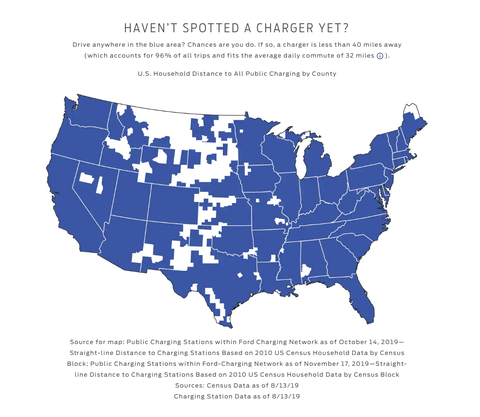There are two major camps in the conversation about the 2021 Ford Mustang Mach-E. Some applaud the marketers for putting the Mustang name on their electric crossover, a tacit statement of confidence that Ford’s willing to put it all on the line. Purists, though, argue that it’s a cynical butchering of the iconic pony car’s name.
Wherever you fall in the naming debate, though, it’s impossible to deny that the Mach-E is shaping up to be the most serious, interesting EV to ever come from the Big Three. It’s too early to say whether it’ll be a serious challenge to Tesla, but here’s what we know about the Mustang Mach-E so far.
It’s Coming Late This Year
The first Mustang Mach-Es are due to dealerships in late 2020, with the midrange First Edition and Premium models scheduled to arrive first. The GT, “California Route 1,” and base-model “Select” won’t go on sale until spring of 2021.
It’ll Go Up to 300 Miles on a Charge
The highest-range Mustang Mach-Es—the Premium or California Route 1 models with the extended range battery and rear-wheel drive—will go about 300 miles on a charge. The lowest range figure models will be Select or Premium models with the standard battery pack and all-wheel drive, both of which are only good for about 210 miles.
All GT models come with the extended-range battery and all-wheel drive, which gives them 250 miles of range. Away-from-home charging will happen in the FordPass Charging Network, which bundles a few popular charging station brands to give you access to over 12,000 stations. The Mach-E can charge at up to 150kW, which should get you from 10 percent to 80 percent charge in 38 minutes. A 47-mile top-up should take 10 minutes.
Performance and Specs
Ford is targeting a mid-three-second 0-60 time for the Mach-E GT Performance Edition, while the Mach-E GT will do the deed in under four seconds. It won’t be besting top-trim Teslas at the drag strip, but Ford points out it’ll be quicker than the Porsche Macan Turbo and other conventional crossovers.
That brisk speed comes from a two-motor electric setup on the Mach-E GT, which should produce 459 hp and 612 lb-ft of torque. For the extended-range, all-wheel-drive, non-GT Mach-Es, Ford is targeting 332 hp and 417 lb-ft of torque. Ford wants that to accelerate quicker than a base Porsche Macan, which Porsche says takes 6.3 seconds to hit 60.
For context, the gas-powered Mustang GT coupe makes 460 hp and 420 lb-ft of torque, hitting 60 in under four seconds. The Mustang EcoBoost makes 310 hp and 350 lb-ft of torque, hitting 60 in under five seconds when equipped with the Performance Package and 10-speed automatic.
But while Ford is hoping that the Mach-E will provide the power and excitement that the Mustang name implies, it’s not promising any sort of track-devouring super-SUV. The Mach-E is a crossover built for the street, with Ford confirming to Road & Track that the car was not built with sustained performance in mind. In November, the Blue Oval wasn’t even sure if it’d be able to do a burnout.
On the bright side—like all Mustangs that have come before it—the Mach-E will make a grumbly noise when you accelerate. If you’re not a fan of faux noise pumped through the speakers, though, you can always turn that off.
Aimed At Tesla
Yes. Here’s the obligatory Tesla-competitor reference. The Mach-E clearly takes inspiration from the market leader in EVs. The interior is where that’s most apparent, with one massive portrait touch screen dominating the center stack. The interior is also minimalist and vegan just like the upcoming Tesla Model Y’s.
You’ll get over-the-air updates through the infotainment system, which also comes with a “Hey Ford” digital assistant. Use that to navigate somewhere and the Mach-E, like a Tesla, will automatically add your charge points to the trip.
Even Tesla’s affection for strange door mechanisms has caught on at Ford. The Mach-E will support phone-as-a-key technology, with no physical door handles on the exterior. There’s a button to pop the door and a fixed door pull, but the idea is that it’ll already be popped when you walk up to the car.
Pricing
The 2021 Ford Mustang Mach-E will start at $43,895 for the standard-range, rear-wheel-drive Select model. The Mach-E Premium starts at $50,600, the California Route 1 goes for $52,400, and the GT is $60,500. All prices given are before options and tax incentives, though you should know that all Mach-Es qualify for the full $7,500 federal tax credit. The First Edition has already sold out.
In terms of long-range EVs, the Mach-E is priced about where we’d expect. It’s significantly more expensive than the $36,620, but it’s bigger, faster, and offers more technology. It’s way cheaper than long-range EVs from Audi and Jaguar, but it’s still undercut by Tesla.
The Model 3—which is a compact sedan rather than a crossover—starts at either $35,000 or $39,990 depending on whether you consider the off-menu standard range model to be a fair comparison. Tesla’s upcoming Model Y, which is a more direct competitor to the Mach-E, should cost $48,000 in long-range guise when it launches. That’s more expensive, but even that base model does 300 miles on a charge. If you’re cross shopping the Mach-E with Teslas, though, it’s important to remember that the federal tax credit has expired for its vehicles.
Source: Read Full Article

